#it is time to create a master doc of my thoughts I suppose. fun project
Explore tagged Tumblr posts
Text
Chapter 104 thoughts
I'm back from posting purgatory and have rewritten, more or less, what Tumblr deleted, so now it's time for my favorite game: Ina Tries To Figure Out What The Fuck Happened In The Latest Noragami Chapter. Spoilers under the cut.
So at the beginning we see trash dad cut himself free from Fujisaki and revert to his original form, while Fujisaki wakes up in Yukine's old house, far from home. I'm really interested to see how much he knows, which I said last time--whether he was aware he was being used or if he's basically been unconscious for the past year. I think he has to be aware on some level, because he knows Father's true name and has to invoke it to summon him from Yomi, but it would also be funny if he flies into a panic, follows the newly created lake, and ends up with the main cast. How far are they from the house, anyway?
Come to think of it, I've been reading Alive since last month (Adachitoka's first manga, which was written by their mentor while they drew the art) and while I'm not done yet, the north of Japan features prominently as a setting for that story and as the final showdown for this one. I'm not sure why, maybe they're from there, but it's interesting.
I'm so glad Yato slammed into trash dad after he insulted Mizuchi. It shows he does recognize her as a victim, and is willing to let things mend between them, since she's had her own character arc since Yato released her name. Don't get me wrong, that was still the right choice for him at the time--but they've both changed since then. And I always love the character development in this manga so this had me bouncing in my seat.
YATO ALSO SAYING HE'S NOTHING BUT A DEAD PERSON LIKE YESSSSSS GET HIM GET HIM KILL HIS MISERABLE ASS
Ahem. I wish Yato had been able to land at least one punch on this horrible man, but it's time for a shounen powerup.
Using the koto no ha on himself grants trash dad access to Izanami/Izanagi level powers, which I think is a temporary powerup that will end with Izanami taking him back to Yomi, because of how he can "feel her breath" on his neck. He plans to then escape again, and possess another body.
This new power is an ass pull as fast-moon put it, but it's also not the first of its kind in Noragami. Think back to Yukine getting cut in half and becoming a hafuri, Amaterasu appearing out of nowhere to give Hiyori the hint that saved Yato's life in Yomi, and how the main characters were saved from the covenant which provided the entire basis for the current arc (due to unresolved tensions between them and the rest of heaven). Basically, in Noragami these things happen with good reason and/or hugely impact the rest of the story, so I think it's best to wait and see how this trash dad development plays out before making judgments on how it affects the writing quality.
There's an old Noragami theory that Father is Izanagi, or stole his power, and it's been mostly dismissed in recent years (but there's an echodrops post about it here if you're interested in the points it made) and even more so since we got snippets of his backstory, but I think it's worth bringing back up now. Izanagi has been suspiciously absent from the manga, and I'm not sure he's even been mentioned, so I wonder if the koto no ha ties into that somehow. Honestly if Izanami killed him in this version of the story and used his power to make the koto no ha, good for her.
Anyway, trash dad reveals he's not just some human who came back from the dead. He can use these powers of creation; it's unclear whether he's used them before, but Yato has never seen him do so--Mizuchi seems to know what he's doing, but it's also unclear whether she's seen it either. I said years ago I don't think it was easy as him just returning from the dead and being granted godlike powers, but I haven't been insistent on it so much because I did a reread of the official translation two years ago and that version heavily implies the only thing trash dad did to get his powers was come back from the dead. I wonder how they'll reconcile that when this volume gets translated (please hold for another 2 years, lmfao).
Is this Izanagi's power, or Izanami's? Did he steal Izanagi's powers next after he paid Izanami a visit? Did he know what using the koto no ha on himself would do? Was it an educated guess based on Izanami's power? Is it still possible he could be a reincarnated Izanagi that believed himself to be human? I don't know if I'd like that last one, but these are the questions I hope to have answered.
Taking a brief detour to discuss that Kiun and Mayu have joined forces to look for their gods, and Ookuninushi is alive but has with him three freshly reincarnated gods--Yatagarasu, Kagutsuchi, and Shinatsuhiko. I'm shocked he lived and they died, but it may lead to an interesting change in heaven where he has to reconcile how they threw away their shinki lives even after they were explicitly told not to use them. The way heaven (and most gods) treat their shinki as not people but disposable tools has been a long-running theme of this manga, and it's been clear larger-scale changes need to be made.
So back to the main event, trash dad creates a biblical sort of flood, but one that brings images of the past. Alongside the tree where a young Yato named Sakura, we also see a cottage and a multi-level house. The cottage may be where Yato and Hiiro were raised, or it might be the one from the Father flashbacks: Check them out side by side:


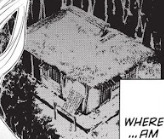
(103-2; page 1 [Father and Kaya village]; 104, page 21; 45, page 33 [Yato, Hiiro, Father cottage] if you want to check for yourself)
Next, there's that multi-story building, which could be the place where Yato made his first kills, or Hiyori's grandmother's house. There isn't much visible, so it's hard to tell, but here's another side by side:


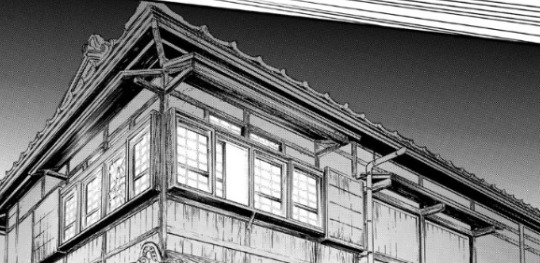
(46, page 9 [where Yato made his first kills]; 104, page 21; 85, page 42 [Hiyori's grandmother's house])
If this enchanted world functions similarly to Hiyori viewing Yato's past while he's asleep, Hiyori will get to experience trash dad's past as it really happened. I've mentioned before it bothers me how the gravekeeper has been narrating the events even though he wasn't present for any of them, so it's entirely likely Father manipulated the facts of his history, or they naturally changed over the course of a thousand years.
I also think Hiyori could find out trash dad's weak point, his true name, if/when she witnesses his past. She could then become his lifeline and decide to let the secret die with her. Or he could possess her, but I'm being optimistic.
The tree she sees is the tree where Yato named Sakura, but it could also have some significance to Father and Kaya; if the cottage where he raised Yato and Hiiro was in the same general location as that village, he could have some memories there.
So if we get Hiyori and Sakura interaction I will cry. If we get Hiyori and Kaya interaction I will also cry.
Next few chapters I'm really excited to see where this enchanted lake dimension thing goes. Yukine could also be caught up in it, depending on how far it has spread, and it'll be interesting to see how Amaterasu reacts to it too.
I don't normally say this, but reblogs are appreciated. This post required a lot of skimming older chapters to tie my thoughts together, and my original draft got half erased when I was just finishing it up so I had to rewrite a lot of it. Plus it seems like everyone was pretty confused by the events of this chapter, so a reblog would help to spread it around and hopefully shed some light on the events. Thanks!
#Noragami#Noragami manga#Noragami spoilers#ngl I am sad it's not a full chapter but did yall see the new springtime lottery art. I cried#I might be back with more thoughts later cause I feel like I couldn't recall everything I had written previously#it is time to create a master doc of my thoughts I suppose. fun project#live update
131 notes
·
View notes
Photo
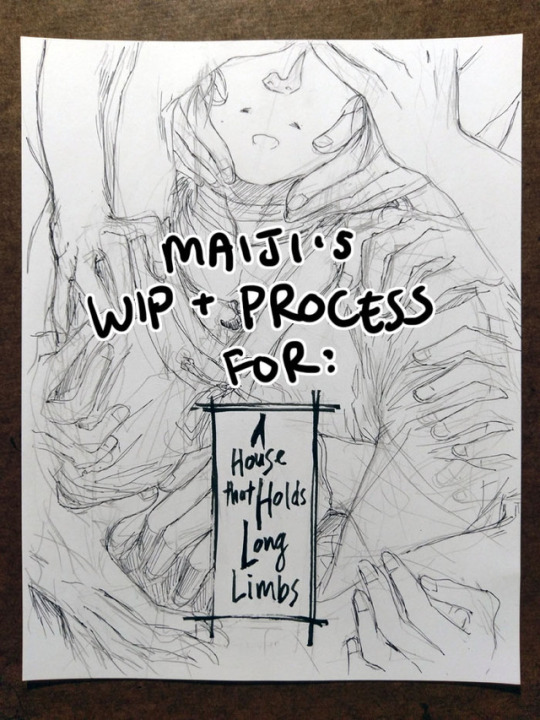
Process and wip images for A House That Holds Long Limbs
You can read the pages for part 1 here (full complete version will be linked from YYH North Bound master post whenever it’s done.)
Every so often I get questions about how I work, and I also enjoy reading about how other creators make things, so perhaps this might be interesting and useful to somebody out there too. I’ve talked about my process before but never really documented and shared it WHILE working on a project, so here you can see some of my thinking and decision-making (and poor habits lol) a bit more immediately, alongside screenshots, photos and scans.
Very long, everything is below the cut, and apologies to people on mobile and anywhere else this goofs up.
One question I get a lot is “do you start with words or pictures when creating a comic?” I jump between both a lot. That said, I tend to lean more heavily on words when documenting ideas in the early stages of a project. This is because, for me:
Words pack a lot of punch in conveying detail quickly. They work better when I need to quickly communicate something extremely specific to future me. I’m a sloppy drawer, so my sketches tend to make future me squint and go, “What the hell was this supposed to be?!”
A great deal of my thinking and planning is done during crowded commutes. It’s more convenient to jot notes on my phone than to whip out my sketchbook and a pen.
(For a while I thought it’d be awesome to have some sort of app where I can type notes AND have an accompanying thumbnail sketch, and be able to drag them around or break them out into more or fewer pages. At one point years ago I thought about creating a custom app... but ultimately too lazy/busy and my current process works well enough. If anyone wants to take this idea and run with it, please feel free to do so and just let me know about it so I can try it haha.)
I usually start with a few lines summarizing the gist of the idea, enough that’s recognizable and I don’t forget the important things to build off from. From there, I start point-form outlining the stuff that needs to happen, structuring them into key scenes/parts. These scenes are not always fleshed out in order - I just add to them whenever I have ideas for that part.
Long Limbs, for example, had a progression like this:
Overall story idea: “horror story with rokurokubi, key plot point(s) happens, the end.” (There was a bit more detail than this, obviously, but we’re avoiding spoilers here.)
Initial description for Part 1 of the story: “Hokushin lured to go to somewhere. Separated from Raizen. HOW??????”
After letting it simmer for while, a solution: “Hokushin annoyed at Raizen. Opportunity for him to get away and go do his own thing.”
Gradually more detail: “Stranger invites him to go to this place to look into something/maybe has a paid job that needs to be done and Raizen is busy goofing off or whatever.”
Problem. I couldn’t resolve this chain of thought to my satisfaction. What kind of task/job can someone convince Hokushin to do on his own when he doesn’t know this person/it seems questionable? And how long will the conversation need to run to establish this as believable?
This was starting to get convoluted and I was getting annoyed because it was turning into a burden in being able to continue the story AND IT WASN’T EVEN THAT IMPORTANT. I decided to abandon this path of thinking, and left the entire story for a while.
Much later (like months?), I had an idea: “Mysterious person drops something, piques Hokushin’s curiosity.” Aha! Hokushin’s own initiative. Simple and plausible enough. HOORAY NO MORE THINKING. LET’S DRAW.
Then I realized, oh shoot, I need to figure out who this mysterious person is and what they dropped. More time passes. And so on… in between I’m always working on other things, so there’s no real creator’s block - at some point I start thinking about this comic again, and ideas work themselves out to some decent level of satisfaction and link together. Thanks subconscious!
Eventually, enough key scenes are fleshed out that I feel confident enough to turn this into a real thing. At present, for example, not all scenes in Long Limbs are totally worked out, but I’ve got enough that I ran ahead with Part 1.
Screenshot of the Google Docs notes/script for Part 1:
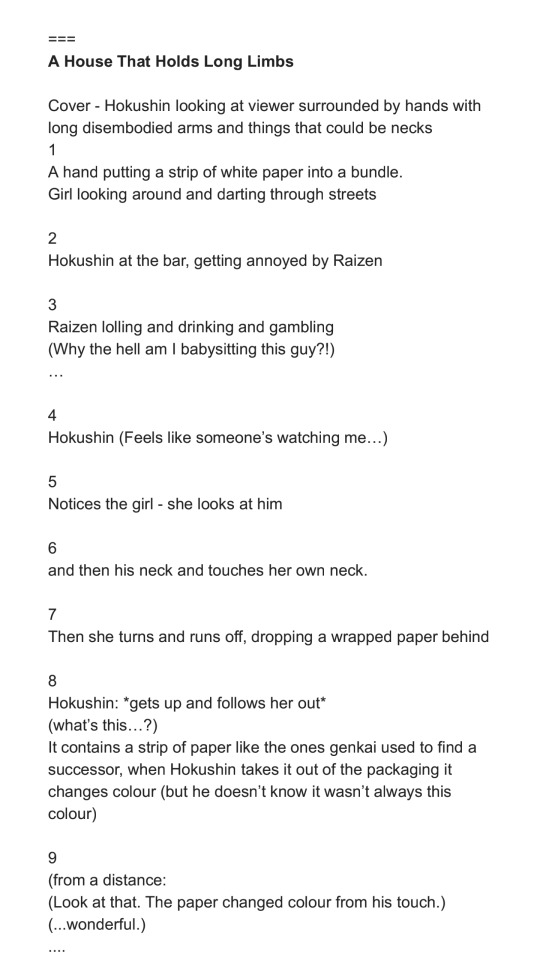
This is a close-to-final version. The === on top is just to separate this from notes on other stories or ideas. This is the beginning of the document, but this document actually includes many other notes and stories for North Bound. I delete them as I finish and post the pages. Every so often I wonder if I should bother keeping them, but they’ve been refined throughout the process and usually don’t bear much resemblance to the original jotted notes anymore. Long Limbs was originally planned to be a later story in North Bound, but I got especially excited about it and fleshed it out further than the others. When I reviewed the earlier stories, I didn’t think there’d be a big continuity or reader experience issue if this was finished and posted first. So I moved the messy notes for this story to the top of the document.
The page breakdown for the script is done by me generally picturing in my head how I might want the scene to go and how much action I might be able to fit on the page for good effect. I’ll sometimes start paginating without thumbnails, and sometimes will do both side by side (thumbnail and update pagination in tandem).
As you might imagine, pagination frequently changes. For example, you’ll see the script above is 9 pages instead of 10.
The original script for this section was broken up into maybe 4-6 pages, with 5-7 being more condensed.
When I started thumbnailing, I found it felt too cluttered and moved too fast.
So I stretched out the part of Hokushin and the mystery girl exchanging glances, and added pages to be able to create a (hopefully) more cinematic feel and really focus on the reason they catch each other’s eye - the bandages on their necks.
I then went back to the Google Doc and updated the script to line it up better.
I was also tweaking the dialogue at the same time and didn’t want to forget any key phrasing I liked. Dialogue is another thing I get really hung up over, often changing words up to the last second. (Sometimes this is because I messed up the size of the speech bubble, if I’m lettering on the computer...)
Thumbnails:
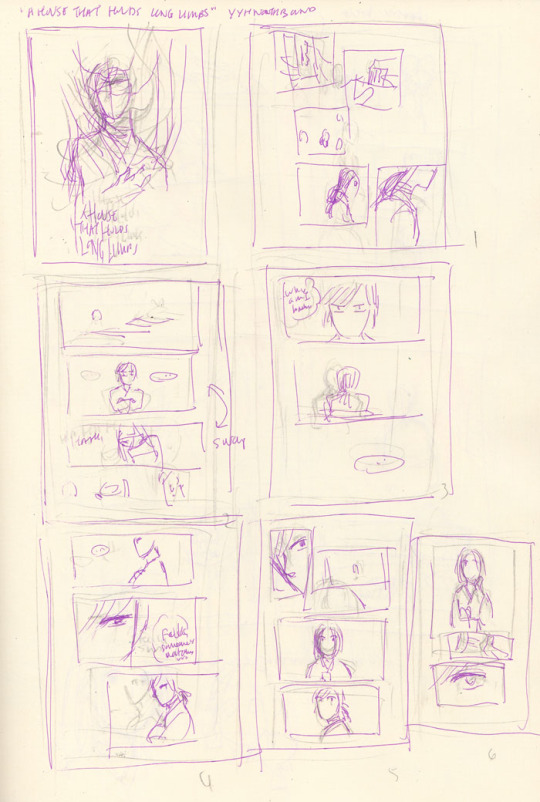
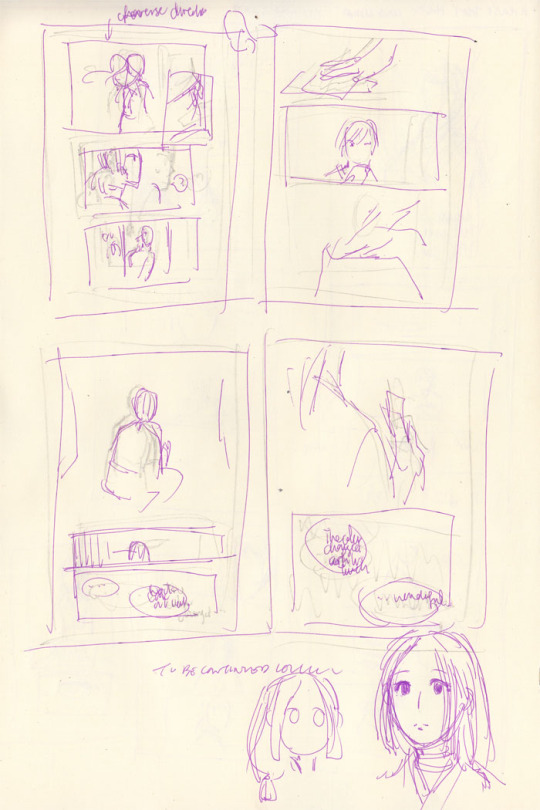
Pretty close to the final in this case - mainly because the sequence is pretty simple and straightforward and not many people are involved. I keep my thumbnails very crappy and rough so that I don’t get upset later when I can’t redraw something as good as the thumbnail. Bottom right was a quick attempt at designing the mystery girl.
Once I think the thumbnails are good enough - translation: I get impatient and just want to start drawing - I proceed to pencils for the actual page.
Throughout all this, I’m repeatedly reviewing script and thumbnail and playing sequences out in my head and then trying to figure out how to better direct the “camera” and the action. I may go back to the script and the thumbnails even as I’m finetuning the actual page if I encounter issues. You can see in both the script and the thumbnails that there are still deviations in the dialogue and the art from the final. Here are a few examples:
Page 3: The panels were originally 1) the setting, 2) Hokushin with his arms folded, 3) Raizen laughing, 4) we see that Hokushin is watching Raizen. After reviewing the thumbnail, I felt it’d be a better setup to flow into the scene if I switched panels 2 and 3. That’s closer to how you’d experience it in real life, or how it might be directed in a shot sequence: you enter an area/place, you hear the sound of some guy’s loud laughter filling the air, then the camera zooms up to the annoyed expression of this one particular dude and you see he’s staring at the laughing guy. Moving from bigger ambience to smaller details around the room.
Page 7: The girl was originally turning in the other direction (hard to tell because I redrew it right on top of the original sketch lol). However, this meant all the directional action would be pointing to the right - Hokushin is facing the right, and when he leaves the bar he’s angling towards the right side of the page. Facing the direction that readers will read in gives a sense of driving the action forward, while facing the opposite direction provides a bit of a mental stop. (This is something from Scott McCloud that always stuck with me.) So, I flipped the girl around.
Page 8: Script has Hokushin going “What’s this?”. When thumbnailing, I thought, “obviously it’s self-evident he’s wondering what this is when he picks it up”. It added nothing to the panel, and the speech or thought bubble would have interrupted the smooth action of him picking up the paper. So, axed.
The damn friggin’ bar and gambling: You’ll see the script mention this, and at one point I actually had the guy standing across from Raizen saying “Is this guy drunk?” I’m actually not sure if they’re in a bar or if Raizen is drinking, but neither were important to the actual story because I just needed Raizen and Hokushin to be in a place where Raizen could hang out with humans and be stupid. So I dropped these details. This is mainly because I ran into historical research problems about bars and alcohol during the Kamakura period (more on that near the end of this post), and this was the only way to stop myself from getting hung up on trying to make it “perfect” and “correct” and just get it done.
Drawing the actual pages. This part is fun!
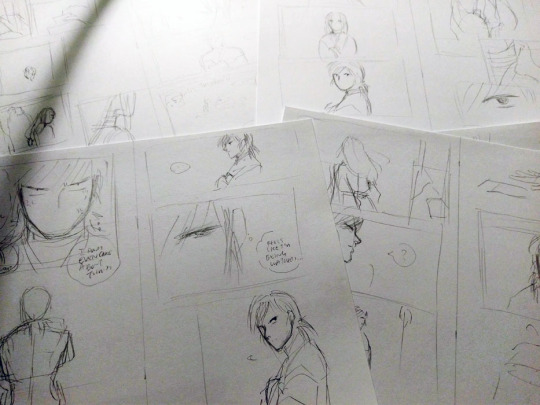
Inking the actual pages. THIS PART IS NOT FUN :(

I don’t have very steady hands and I get very anxious about messing things up, so inking always takes me the longest. (I also get distracted easily, e.g., ink two lines and then surf tumblr for ten minutes lol). I’ve improved a lot since I started drawing comics much more frequently a couple years ago, and my choice of tools and style has helped a lot (I lean to variable lines and sketchy style, which is more forgiving than, say, a very precise art style with fixed-width pens) but I still get nervous at this stage.
I’m very lazy so I usually stick with one tool for inking. For Long Limbs I tried to effort more and actually used three. Right to left: Sailor fude de mannen for panel borders and text, Muji pen for artwork (0.4 because that was the only size available at the store when I went to get my refill), Pentel pocket brush for filling in blacks. I refill the fude de mannen and the pocket brush with fountain pen inks.
I usually ink panel borders first, then speech bubbles, then everything else. I hop all over the place and pages are generally in varying stages of completion. I also sometimes add in some more text lines because it seems like a good idea at the time - Hokushin’s complaint on page 3 about how he should have left Raizen when he got into a fight with a fish-seller in a previous story, for example. Sometimes these work, sometimes I regret it later and edit it on the computer.
Cover thumbnails and pencil sketch:
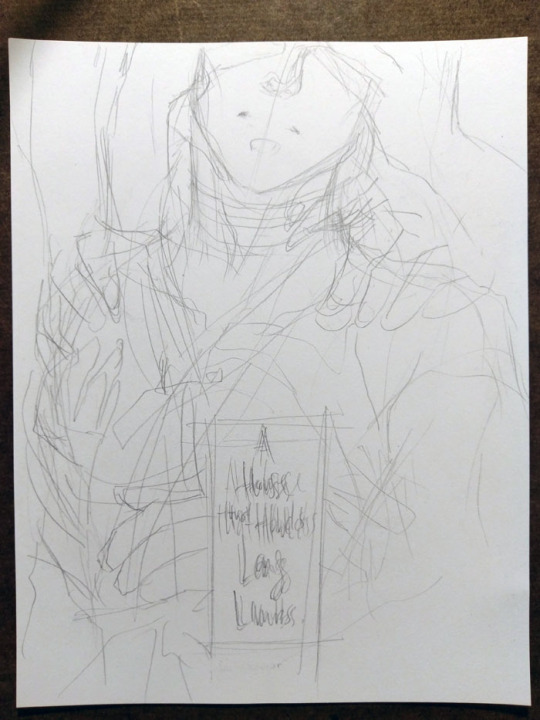
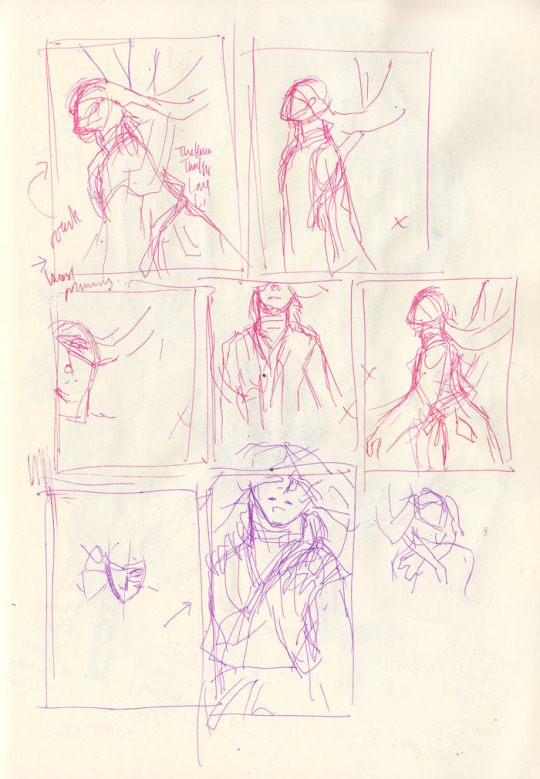
The one in the page thumbnails was the original idea, but then I thought, “seems kinda cliched. Can I get a more interesting angle where he’s not looking straight at the viewer?” (OK, his eyes are covered, but you know what I mean.) I quickly tried a few other angles and compositions, didn’t like them and ended up going with pretty much the original idea, but more zoomed in.
In the thumbnails, you can see all my little x’s indicating “ehhhh I don’t like this”. I wanted something with a particular mood/atmosphere especially with all the hands and arms, and I was conflicted between zooming out (for more environment and more arms, and the focus on the “long limbs” part of the title) or having a tighter, more close up shot. Ultimately I think the latter works better as it conveys a sense of claustrophobia, and it’s more intimate which supports the idea of psychological horror. ALSO IT’S SEXY (maybe???). The end.
Other random thoughts:
I took a lot of heart/inspiration/motivation from Togashi’s last few volumes of Yu Yu Hakusho to keep the backgrounds as lazy - I mean sparse - as possible and also speech bubbles over plain backgrounds lmao. I think it takes a lot of confidence (or maybe laziness) to be so minimalist and restrained, and it’s an impressive and economical way of working. I was always impressed that when reading those pages of his for the first time, the lack of detail never really bothered me - you had everything you needed for your brain to comfortably fill in the gaps and complete the sense of narrative and story progression, and there are still visual flourishes when the situation calls for it. So I’m trying to bring a bit of that tighter philosophy in.
Research. I struggle a LOT with not getting bogged down by details, especially when it’s something “just” for fun or “just” a fancomic. I have very lovely and helpful friends and family who every so often patiently allow me to whine and bounce things off of them, help me look things up, and/or tell me when I’m getting myopic about stuff. For all the North Bound comics, finding quick and useful historical references for the time period has been a challenge. There’s a ton about aristocracy and warriors but very little about the ordinary/common people, not surprisingly. I frequently question my instincts about what makes sense because I tend to automatically draw on similar/equivalent Chinese culture (there was certainly lots of cross-over, but not always appropriate/relevant) or Edo period references (wrong time frame! Too far in the future). I often end up losing a ton of time trying to find something with roundabout searches, and then give up and look at other comics I have close enough to the time period. And then referencing those and compounding whatever historical errors they have in them. (e.g., “Well if it was good enough for Osamu Tezuka’s Phoenix it’s good enough for this rando fancomic!”) I just would like historical/subject matter experts to know I did try...
#yu yu hakusho#comics#hokushin#raizen#fanart#process#wip#art by Maiji/Mary Huang#sketches#art supplies#yyh north bound
9 notes
·
View notes
Text
Day 9: Possibility
I'll admit, I'm getting a little bogged down by having to read several different Django tutorials that all basically say the same thing.
Dain explains in the Advanced Beginner Challenge that it's about social context — by the time we actually begin to work with the code, we will have seen the instructions a bunch of times and gotten a sense of the community and best practices.
And I'm doing it! But I couldn't help myself — I started some other projects.
I've been interested, for a long time, in software that would help musical theater collaboration teams to work better together. Of course, what comes to mind right away is a fully-featured, online collaboration tool, with everything from videoconferencing to version control to task management…
But honestly, it's way beyond my skill level. And anyway, there are a zillion different tools that already do those things better than I likely ever could.
I realized today, though, that Final Draft and Finale — the applications my collaborator and I use to write musicals together — both export data in some form of XML. Between the two applications, there's a lot of redundancy. One of those redundancies is lyrics.
That is to say, when my collaborator prepares a libretto for a scene that includes a song, and I prepare a lead sheet or fully-realized arrangement of a song, we both type in the lyrics manually. Because of that, there's a high chance of discrepancies between the two, especially when we're both tired and overwhelmed.
It's the kind of thing that a music editor would help to mitigate, but that's… not always in the cards.
So I thought, What if there's a way to extract lyrics from both MusicXML files and Final Draft documents and compare them?
As I began to dive in to the file formats, I realized it's no easy task: Final Draft creates <text></text> tags for every word, and MusicXML's specification separates words by syllable.
I was, ultimately, able to create a function that concatenates MusicXML syllables extracted from an uncompressed .musicxml file with one voice and print() the resulting text to the screen.
And as I tried to make sense of Final Draft's implementation of XML (with some friends' sample scripts at my fingertips), I thought, There's got to be a way to parse this and convert it to HTML so folks don't have to spend $250 on the software just to be able to open their collaborators' scripts. Surely, there are implementations out there.
I even spent some time learning how to render a website so it looks like a page, and how to make print-friendly CSS. How cool would it be to make a Flask app that accepts a Final Draft script, extracts metadata, and renders a nice, HTML site that's paginated and printable?
In my cursory search, I found a parser by Alex Coppen called screenplay-parser. But, perhaps more interestingly, I found his specification for a ScreenJSON file format that treats screenplays as JSON objects. It's pretty cool.
And it's a cool medium- to long-term project: to figure out how to implement a web application — probably in Django — that can accept a ScreenJSON object and render a rich, web-friendly screenplay, complete with access control for each element, version control, and tons of metadata.
As far as I can tell, it's not been implemented yet, and Coppen's ScreenJSON specification is yet to be adopted.
What if there's a future in which I could develop a web-based tool that can read and write MusicXML and Final Draft, store an annotated, canonical libretto with version control and hypertext to sound files and sheet music, and can even automate the process of creating an integrated score? Lilypond is supposed to be very good at automatic music formatting, and there are tools to convert MusicXML to Lilypond.
Ah. I'm probably getting ahead of myself, but I have to admit — it's fun to think about what's possible.
#alex coppen#musicxml#screenjson#final draft#finale#music#screenwriting#collaboration#musical theater#python#web development#django#flask#job search#lilypond#advanced beginner challenge#dain miller
0 notes